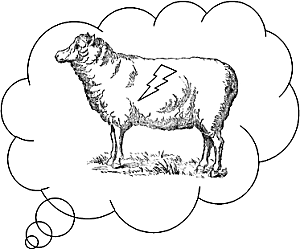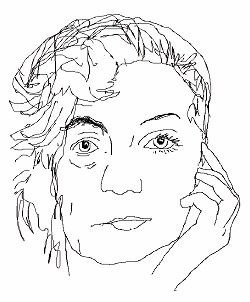 The new Blade Runner film has generated fresh interest in the original film; over on IAI Helen Beebee considers how it nicely illustrates the concept of ‘q-memories’.
The new Blade Runner film has generated fresh interest in the original film; over on IAI Helen Beebee considers how it nicely illustrates the concept of ‘q-memories’.
This relates to the long-established philosophical issue of personal identity; what makes me me, and what makes me the same person as the one who posted last week, or the same person as that child in Bedford years ago? One answer which has been a leading contender at least since Locke is memory; my memories together constitute my identity.
Memories are certainly used as a practical way of establishing identity, whether it be in probing the claims of a supposed long-lost relative or just testing your recall of the hundreds of passwords modern life requires. It is sort of plausible that if all you memories were erased you would become new person with a fresh start; there have been cases of people who lost decades of memory and underwent personality change, identifying with their own children more readily than their now wrinkly-seeming spouses.
There are various problems with memory as a criterion of identity, though. One is the point that it seems to be circular. We can’t use your memories to validate your identity because in accepting them as your memories we are already implicitly taking you to be the earlier person they come from. If they didn’t come from that person they aren’t validly memories. To get round this objection Shoemaker and Parfit adopted the concept of quasi- or q-memories. Q-memories are like memories but need not relate to any experience you ever had. That, of course, is too loose, allowing delusions to be used as criteria of identity, so it is further specified that q-memories must relate to an experience someone had, and must have been acquired by you in an appropriate way. The appropriate ways are ones that causally relate to the original experience in a suitable fashion, so that it’s no good having q-memories that just happen to match some of King Charles’s. You don’t have to be King Charles, but the q-memories must somehow have got out of his head and into yours through a proper causal sequence.
This is where Blade Runner comes in, because the replicant Rachael appears to be a pretty pure case of q-memory identity. All of her memories, except the most recent ones, are someone else’s; and we presume they were duly copied and implanted in a way that provides the sort of causal connection we need.
This opens up a lot of questions, some of which are flagged up by Beebee. But what about q-memories? Do they work? We might suspect that the part about an appropriate causal connection is a weak spot. What’s appropriate? Don’t Shoemaker and Parfit have to steer a tricky course here between the Scylla of weird results if their rules are too loose, and the Charybdis of bringing back the circularity if they are too tight? Perhaps, but I think we have to remember that they don’t really want to do anything very radical with q-memories; really you could argue it’s no more than a terminological specification, giving them license to talk of memories without some of the normal implications.
In a different way the case of Rachael actually exposes a weak part of many arguments about memory and identity; the easy assumption that memories are distinct items that can be copied from one mind to another. Philosophers, used to being able to specify whatever mad conditions they want for their thought-experiments, have been helping themselves to this assumption for a long time, and the advent of the computational metaphor for the mind has done nothing to discourage them. It is, however, almost certainly a false assumption.
At the back of our minds when we think like this is a model of memory as a list of well-formed propositions in some regular encoding. In fact, though, much of what we remember is implicit; you recall that zebras don’t wear waistcoats though it’s completely implausible that that fact was recorded anywhere in your brain explicitly. There need be nothing magic about this. Suppose we remember a picture; how many facts does the picture contain? We can instantly come up with an endless list of facts about the relations of items in the picture, but none were encoded as propositions. Does the Mona Lisa have her right hand over her left, or vice versa? You may never have thought about it, but be easily able to recall which way it is. In a computer the picture might be encoded as a bitmap; in our brain we don’t really know, but plausibly it might be encoded as a capacity to replay certain neural firing sequences, namely those that were caused by the original experience. If we replay the experience neurally, we can sort of have the experience again and draw new facts from it the way we could from summoning up a picture; indeed that might be exactly what we are doing.
But my neurons are not wired up like yours, and it is vanishingly unlikely that we could identify direct equivalents of specific neurons between brains, let alone whole firing sequences. My memories are recorded in a way that is specific to my brain, and they cannot be read directly across into yours.
Of course, replicants may be quite different. It’s likely enough that their brains, however they work, are standardised and perhaps use a regular encoding which engineers can easily read off. But if they work differently from human brains, then it seems to follow that they can’t have the same memories; to have the same memories they would have to be an unbelievably perfect copy of the ‘donor’ brain.
That actually means that memories are in a way a brilliant criterion of personal identity, but only in a fairly useless sense.
However, let me briefly put a completely different argument in a radically different direction. We cannot upload memories, but we know that we can generate false ones by talking to subjects or presenting fake evidence. What does that tell us about memories? I submit it suggests that memories are in essence beliefs, beliefs about what happened in the past. Now we might object that there is typically some accompanying phenomenology. We don’t just remember that we went to the mall, we remember a bit of what it looked like, and other experiential details. But I claim that our minds readily furnish that accompanying phenomenology through confabulation, given the belief, and in fact that a great deal of the phenomenological dressing of all memories, even true ones, is actually confected.
But I would further argue that the malleability of beliefs means that they are completely unsuitable as criteria of identity; it follows that memories are similarly unsuitable, so we have been on the wrong track throughout. (Regular readers may know that in fact I subscribe to a view regarded by most as intolerably crude; that human beings are physical objects like any other and have essentially the same criteria of identity.)

